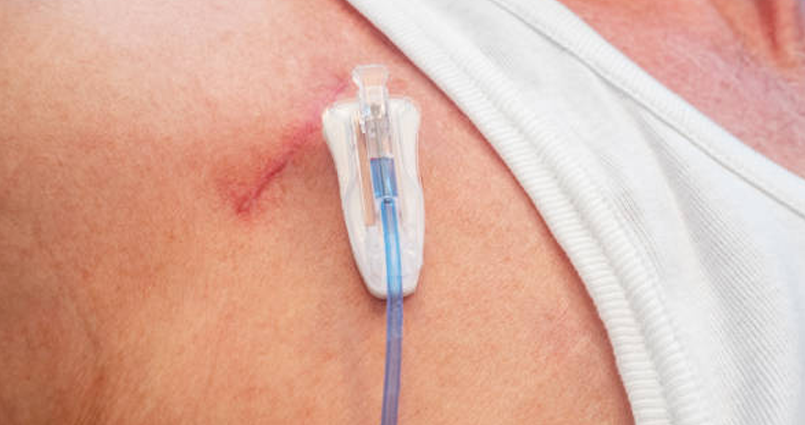Chemotherapy, a cornerstone of cancer treatment, often involves the administration of powerful drugs to combat cancerous cells. For many patients undergoing chemotherapy, frequent injections or intravenous (IV) infusions are necessary. However, repeated needle sticks can be uncomfortable and challenging, especially for those undergoing prolonged treatment. To alleviate these concerns, healthcare providers may recommend the use of a Port-a-Cath in chemotherapy. In this blog post, we’ll explore the role of Port-a-Cath in chemotherapy treatment, its benefits, and how it enhances the patient’s experience during cancer care.
What is a Port-a-Cath?
A Port-a-Cath, also known as a port, is a small medical device implanted under the skin that provides easy access to a vein. It consists of a reservoir or port connected to a catheter, which is inserted into a large vein, usually in the chest. The port is typically made of durable materials such as silicone or titanium and is designed to withstand repeated needle punctures for chemotherapy infusions and blood draws.
Role of Port-a-Cath in Chemotherapy Treatment
Port-a-Cath plays a crucial role in chemotherapy treatment by providing a reliable and convenient access point for administering chemotherapy drugs directly into the bloodstream. Unlike traditional IV lines, which are inserted into peripheral veins in the arms or hands, Port-a-Cath is connected to a central vein near the heart, ensuring rapid and efficient delivery of medications throughout the body. This direct access to the bloodstream allows for the administration of chemotherapy drugs at higher doses and with greater precision, enhancing their effectiveness in combating cancer cells.
The Installation Process of a Port-a-Cath in Chemotherapy
The process of installing a Port-a-Cath is a minor surgical procedure performed under local or general anesthesia. The port is usually inserted in the upper chest, and the catheter is threaded into a large vein. Once installed, the port can remain in place for several months or even years, making it a convenient option for patients undergoing long-term chemotherapy treatment.
Benefits of Port-a-Cath in Chemotherapy
The use of a Port-a-Cath offers several advantages for patients undergoing chemotherapy treatment:
- Reduced Discomfort: One of the primary benefits of using a Port-a-Cath in chemotherapy is reduced discomfort for patients. Rather than undergoing frequent needle sticks for IV access, patients with a Port-a-Cath can receive chemotherapy infusions through the implanted device, minimizing pain and discomfort associated with needle insertion.
- Minimized Vein Damage: Prolonged chemotherapy treatment can cause damage to the veins, leading to vein irritation, inflammation, and even thrombosis (blood clots). By bypassing the peripheral veins and accessing the central venous system, Port-a-Cath helps minimize the risk of vein damage and associated complications.
- Convenience and Flexibility: Port-a-Cath offers patients greater convenience and flexibility during chemotherapy treatment. The device remains in place for the duration of treatment, eliminating the need for repeated vein punctures for each session. Patients can receive chemotherapy infusions more efficiently and with fewer disruptions to their daily activities.
- Improved Cosmetic Appearance: Unlike external IV lines, which may be visible and cause self-consciousness for some patients, Port-a-Cath is implanted beneath the skin, resulting in a more discreet and cosmetically pleasing appearance. This can enhance the patient’s overall comfort and sense of well-being during chemotherapy treatment.
What to Expect During Port-a-Cath Placement
The placement of a Port-a-Cath is typically performed as a minor surgical procedure under local anesthesia. The port is implanted under the skin, usually in the chest area, and the catheter is threaded into a nearby vein. Following placement, patients may experience some discomfort or soreness at the insertion site, but this can usually be managed with over-the-counter pain medication.
Caring for a Port-a-Cath
Proper care and maintenance of a Port-a-Cath are essential to ensure its functionality and prevent complications. Healthcare providers will provide instructions on how to care for the port, including guidelines for flushing the port regularly with saline or heparin solution to prevent blockages and infections. Patients should also avoid activities that may damage or dislodge the port, such as heavy lifting or wearing tight clothing.
Conclusion
Port-a-Cath in chemotherapy plays a vital role in treatment by providing a reliable and convenient access point for administering chemotherapy drugs directly into the bloodstream. Its benefits, including reduced discomfort, improved safety, convenience, and enhanced quality of life, make it an invaluable tool in the fight against cancer. If you or a loved one is undergoing chemotherapy treatment, consider discussing the option of Port-a-Cath with your healthcare provider to determine if it’s the right choice for you. With its ability to streamline chemotherapy administration and improve patient comfort, Port-a-Cath is helping to redefine the standard of care for cancer patients around the world.

